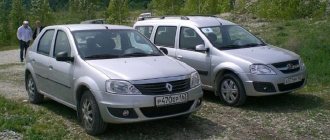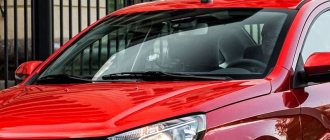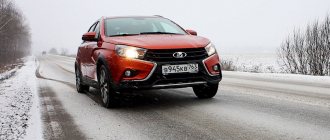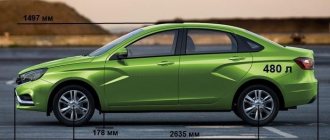I didn’t seem to be planning to settle in a tree with a bear, like in the commercial for the new Lada Xray Cross. In Sochi, I was planning to drive more on asphalt, but instead I climb higher and higher into the mountains, dodging trees, shooting stones from under the wheels. And where? To a place called "Bear's Corner"! Izvestia investigated why Xray Cross still looks into the forest.
The National Award for Automotive Business Experts has started in Russia
A completely different Xray
An Xray Cross with a new “robot” AMT was brought to a special event organized for members of the jury of the Top 5 Auto automobile award. And, as it turned out, by mistake. The car was removed from the test, citing the fact that it was a pre-production sample, and the updated AMT gearbox was offered to be tested on the Vesta.
Until recently, the Xray crossover was the most expensive model of the Lada brand, based, albeit on a foreign, but simple Renault platform - from Logan and Sandero. While working on the even more expensive Xray Cross, in Togliatti they decided to seriously modify the truck that AvtoVAZ had inherited - its inherent shortcomings for such a car were already becoming critical.
Xray Cross
Xray Cross
Photo: Lada
For example, the hydraulic booster lacked performance, causing the steering wheel to receive shocks from bumps. That's why the off-road Xray has a completely new electric boost and a new rack. Due to the increased ground clearance to 215 mm and a wider track, the suspension was completely redesigned, using a bizarre mixture of parts from Vesta and Duster. The same is with the brakes - discs from Vesta Cross on the rear axle instead of drums and a more powerful vacuum booster from Renault Duster.
MIAS 2018: the brightest and most anticipated automobile premieres
Manufacturers from Russia and China took the lead
By the way, Steve Mattin insisted on increasing the track - due to the plastic body kit, the car body became wider and without widely spaced wheels the Cross version would not have looked so harmonious. Harmony was added by 17-inch wheels and an off-road body kit - it performs not only a protective function, but also an aesthetic one. In any case, compared to the athletic Cross version, the Xray seems heavy and clumsy.
Why did it happen that it has changed now?
Theoretical basis
The basis of the CVT gearbox is a 5-speed manual transmission from VAZ, but it is equipped with actuators from ZF from Germany. The Lada robot box was first released in 2014 and installed on the Priora, then gradually moved to the Vesta, which needed 2-pedal versions, as if in the air - after all, the car’s competitors are foreign cars, while consumers do not like manual gear shifting .
The Lada robot box did not go well with its status.
However, Lada specialists replaced the firmware, conducted experiments with the clutch, then made a significant change in 2018, which was announced simultaneously with the release of the Vesta Cross sedan, but during a test in May these cars simply...disappeared.
For this reason, the wait dragged on until November.
Move the sofa
No savings on comfort. For the first time in the history of Lada, the steering wheel is heated along the entire rim and for the first time in the history of the B0 platform, it is adjustable for reach. The new seats - the backrests are borrowed either from the Nissan Qashqai or from its French relative Renault Kadjar - are comfortable and equipped with three-stage heating.
The back of the rear sofa was moved back a couple of centimeters, thanks to which there was additional space in front of the passengers’ knees. A little space has been freed up, but this increase is also relevant - the back row of the Xray is cramped. Additionally, the design of the front seats has been changed, and now you can put your feet deeply under them.
Xray Cross
Xray Cross
Photo: Lada
Due to manipulations with the second row, the trunk decreased by only a liter, but the loading capabilities of the Xray Cross, on the contrary, increased. First of all, thanks to the back of the right front seat, which lies in the horizon, and secondly, thanks to the roof rails that can withstand a 50-kilogram weight.
Advantages and disadvantages of the robot on Vesta
The advantage of a robot over mechanics: convenience, because Only one leg is occupied, both hands are on the steering wheel.
The advantage of a robot over an automatic: it is more economical (What is the fuel consumption?) than a conventional automatic, you can tow a car, slipping is allowed on the roads, the dynamics of the “mechanics” are preserved.
It is also worth noting that the robot has protection against “crooked hands”. In other words, randomly switching the robot selector while driving will not cause any damage. In addition, Priora, like Vesta on a robot, can be started from a pusher, you can drag a trailer, tow a car - you just need to switch to mechanical mode.
The first robots were installed on the Lada Priora with a 1.6 liter engine producing 98 hp. But the robot has already been reprogrammed for the new 127 engine, paired with which Vesta will be produced.
When slipping during the start, for example, on snow, the AMT can engage both second and third gear.
Possible hang-ups in gear, for example, after speed bumps, the robot will not immediately engage second. In this case, you can switch to manual switching mode.
Let's start with the advantages. According to reviews of the robot on Vesta, the machine has the following undeniable advantages:
- Equipped with the “Slope Start Assistant” program – even if you park or get stuck in a traffic jam on a slope, this option will help you avoid rolling back when starting. The gearbox increases speed at the start, the clutch becomes stiffer.
- Increased clutch life - thanks to the soft and smooth operation of the AMT, the service life of the part will be long even with careless driving. The shift box is protected against accidental pressing of the lever: if you start shifting it chaotically, the car simply will not react.
- AMT is adaptive and has 26 behavior patterns that it selects depending on the driver’s behavior. How it works? The program reads how the driver operates the gas pedal and, depending on this, switches the clutch at the right moment.
- Fuel economy is hard to believe, but the robot on the Lada is really more economical than a manual or automatic transmission. Thanks to smooth switching, you can use several times less gasoline.
- AMT consumes less oil than manual transmission - also a significant factor in favor of choosing a new configuration.
See about copters: iRobot brand store. iRobot robotic vacuum cleaners with delivery throughout Russia
Reviews of the robot box on Vesta also show the disadvantages of an automated manual box:
- The absence of a parking mode makes parking more difficult; when parking, it is better to leave the control lever in manual or automatic mode to avoid rolling back.
- Gear changes are jerky - between 1st and 2nd gears there is a decrease in speed, which can noticeably slow down the car.
- Slow acceleration - a car with AMT takes a few seconds longer to pick up speed than a car with a manual transmission.
- The inconvenience of the manual mode is that the gearbox is not designed very well, and this makes manual driving of the car less convenient.
Off-road without shaking
Lady X: a girl from Togliatti has become prettier and invigorated
Test drive of the updated Lada Granta
All-season tires with a rare size of 215/50, specially created for the Xray Cross, hum on the asphalt quite clearly, despite the improved sound insulation. Engine 1.8 with 122 hp. - and this is the only unit available for the new crossover - is also loud, especially in sport mode. The “sport” button, albeit at the sensation level, compensates for the loss in dynamics: the Xray Cross accelerates to hundreds a little longer. And it consumes more gasoline, so for highway travel it would be nice to add a sixth stage to the gearbox.
The role of the Xray Cross is “a car for our roads”, so stay away from the well-maintained Sochi highways and buildings shining with dark glass. On a broken winding road that leads into the mountains, to shabby houses and colorful beehives. Cross can go quite fast off-road.
The suspension has a good reserve of energy capacity, pile fender liners and shields under the sills made of the same material extinguish crushed stone shots. The plastic body kit, which is also glued to the body with double-sided tape for reliability, protects the paint from stones and branches. The steering column, although it shakes on bumps, is much less than in cars on the B0 platform - Renault Duster and Sandero Stepway.
Xray Cross
Xray Cross
Photo: Lada
An honest toy: what foreigners think about new AvtoVAZ models
How Russian cars are valued in Europe and the USA
The wide track and rear disc brakes make deceleration predictable, even if the wheels have varying levels of grip. In addition, in the “sand” mode, ABS works in such a way that a roller is formed in front of the wheels, which further slows down the car on soft ground.
Test drive by specialists
What do professionals say about the robot box in Lada Vesta? You can find many reviews of the new product on the Internet. Most note the slow response of the box during acceleration. Some call the driving style of the Lada Vesta robot a style for summer residents. Slow acceleration of the car contributes not only to fuel economy, but also to passive safety.
No matter how hard you try to squeeze out maximum speed in order to overtake three or two cars, it is unlikely that you will be able to do it quickly. True, the car behaves a little more cheerfully in manual mode, in which it is more realistic to squeeze the maximum out of the 1.8-liter engine. But, if you get used to this driving style, you begin to notice the advantages: the parts are made well and do not fail for a long time. Compared to manual and automatic transmissions, AMT provides significant fuel savings.
After the driver presses on the gas and the engine picks up speed, the transmission begins to upshift. The problem is that the robot on the Vesta cannot do this without reducing the thrust. The switching time fluctuates around 2 seconds, which can be quite annoying at first. But you won’t feel any jerks, the clutch is as smooth and comfortable as possible.
But, despite various points of view, most reviews about the Vesta 1.8 robot indicate that the introduction of an automated manual transmission was a big leap forward for the domestic manufacturer. Car enthusiasts hope that the improvements will not end there; Lada engineers will properly finalize the box, and it will be a pleasure to drive.
Puck in play
The washer of the newest Ride Select system, in addition to the sand mode, offers another off-road mode - for snow and mud. All this gives rise to a feeling of permissiveness, but neither electronics nor increased suspension travel can replace four driven wheels. The system will help you not get stuck in the sand or start moving on a slippery slope - it really helps, it’s been tested. It is better to take more difficult sections on foot. Fortunately the chassis allows it.
I retell to XRAY project director Oleg Grunenkov the rumors circulating on the Internet about the development of an all-wheel drive system for Xray, and he looks skeptical. Firstly, it is expensive - you will have to redo the entire rear part of the car. Secondly, why? Most competing crossovers are popular in single-wheel drive versions. For a Russian buyer, an automatic is more important, and this is precisely what the Xray Cross does not yet have.
AvtoVAZ will receive money for Lada Van
The nuances of driving the Vesta robot
As with all cars, when driving a Lada robot, there are some nuances that should be taken into account when purchasing. They can be understood most clearly if you read the reviews about the robot on Vesta. For example, the gearbox is sometimes tricky when changing gears. If you are driving in second gear, slowly picking up speed, the robot may misunderstand you and shift to first gear instead of third. This often happens during not very dynamic acceleration.
If you need a faster start, there is a little trick. Usually, when driving on the highway, the robot engages fifth gear. If you press the gas pedal to the floor, the car engages third gear, after which the speed immediately increases. This allows you to overtake on high-speed sections of the road. After completing the maneuver, just release the pedal to its normal state, and the AMT will switch back to 5th gear.
As we have already said, a processor is inserted into the robot on the Lada, which reads the behavior and driving style of the driver and adapts to it. If you want the most dynamic acceleration without jerking, then you can try the following driving style:
- Accelerate without releasing the gas pedal. The robot itself will select the right moment to shift from first gear to second, and then to third. But be prepared for a slight jerk between shifts.
- Once your car reaches a speed of 40 km/h, release the gas pedal slightly. At this moment, the car will smoothly shift gears.
- The same action must be repeated at a speed of about 60-80 if you are going to go even faster.
- If at speed 4 you do not press the gas pedal to the floor, then, most likely, AMT will immediately set speed 5, at which dynamic acceleration is impossible.
- When driving uphill, the robot itself slows down if it becomes difficult for the engine to hold the current gear. For beginners, this nuance is especially good: now your car will definitely not stall while climbing a slope.
You still need to get used to driving a manual automatic transmission, but the convenience and reasonable cost of the AMT completely hides all its shortcomings.
Learning "robot"
AvtoVAZ has already assembled a batch of Crosses with Japanese CVTs and 114-horsepower engines, but for now, the AMT robot, familiar to Lada owners, first introduced back on Priora, will be responsible for “automation”. However, not so familiar. Its updated version 2.0 can crawl in traffic jams like a real machine. Previously, when the brake pedal was released, the car with the “robot” stood still, but now it moves slowly, both forward and backward. If you open the door or tighten the handbrake, the car will remain in place.
Photo: Lada
According to the project manager, Vladimir Petunin, the transmission was not seriously altered, limiting itself to only a new control unit with new firmware and other disc linings. It will not be possible to fill an old “robot” with new brains. At the same time, in creeping mode, the only clutch does not slip, so its declared service life is still 150 thousand km.
The switching algorithm has been improved, now the “robot” should change gears smoother and faster. And indeed, the transmission on the Vesta SW Cross station wagon is trying its best: it quickly responds to gas supply, and shifts downward with throttle shifts. But sharp acceleration with the pedal to the floor still turns out wavy. Robotic gearboxes with one clutch cannot operate smoothly, even on supercars. But in any case, AMT copes better than its analogues from the budget class and the average manual driver.
Vesta SW Cross
Vesta SW Cross
Photo: Lada
Casket of sports: test drive of the fastest Lada Vesta
What to expect from a sports flagship from Togliatti
I was surprised that after a long period of pushing in a traffic jam, the smell of a burnt clutch appeared in the car. Algorithms do not always work correctly. For example, the robot should shift to a downward gear if you slow down while moving downhill, but in reality it does this every other time.
What is the difference between AMT and automatic transmission?
How does the robot on the Vesta work and how does it differ from a car with an automatic transmission? In terms of structure, it is designed exactly the same as a manual transmission. A robotic one has little in common with an automatic transmission. If in a conventional automatic transmission the torque is transmitted from the engine to the wheels by a torque converter, then in a robotic gearbox the torque is transmitted through gears.
When developing the new box, engineers from the Tolyatti plant used the experience of foreign manufacturers. And the clutch included in the AMT package is made in France. The part is protected by a wear compensation function that prevents premature failure. There have not yet been any cases of warranty claim registered.
Many people are perplexed: why can’t an automatic transmission be developed on a Russian basis, because so far no domestic car has such an improvement. The answer is simple: the development of automatic transmissions is possible already on the existing base, which does not yet exist in Russia. And production based on foreign developments will significantly increase the final cost of the car. For comparison, using an automatic machine will cost approximately twice as much as a robot.
What configuration does the AMT come with?
Lada Vesta with an automated manual transmission is available only in luxury configuration. When purchasing this assembly, you can also purchase a manual transmission, which is standard. But for the robot you will have to pay about 25,000 rubles.
Considering that the price for a Lada Vesta in the maximum configuration exceeds 600 thousand, a reasonable question arises: is the game worth the candle? What advantages and disadvantages can be found in such a supplement?











